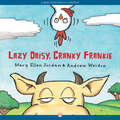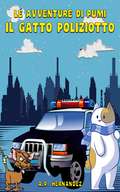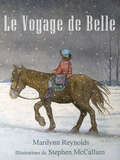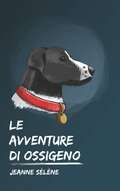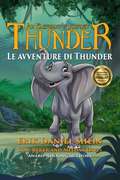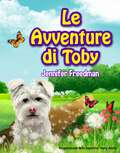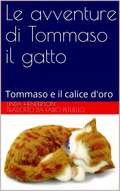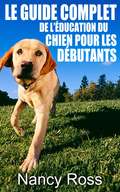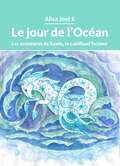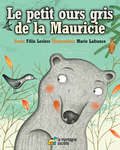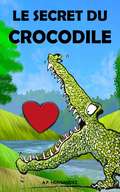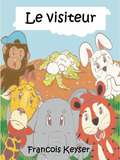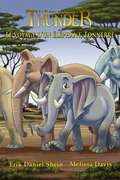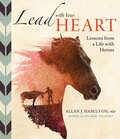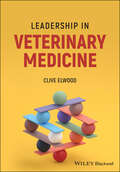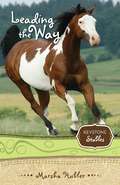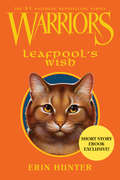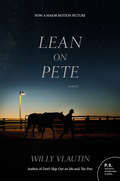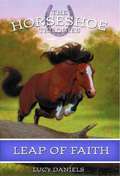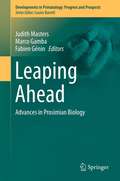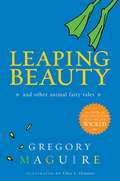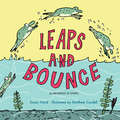- Table View
- List View
Lazy Daisy, Cranky Frankie
by Andrew Weldon Mary Ellen JordanA quirky, rhyming picture book about farm animals behaving badly before bedtime."This is my cow, she's called Daisy. She should eat grass but she's too lazy. Instead she eats jelly on a spoon, all through the morning till late afternoon." This quirky, rhyming picture book about farm animals behaving badly will have children laughing and, eventually, lull them to sleep along with the tuckered-out animals. This is a fixed-format ebook, which preserves the design and layout of the original print book.
Le Avventure di Pumi, il Gatto Poliziotto: Libri per bambini. Lettura dai 6-7 ai 10-11 anni.
by A. P. HernándezPumi è un gatto molto particolare. A differenza dei suoi fratelli, che amano cacciare, graffiare i cuscini del divano e fare grandi corse, a Pumi piace guardare le stelle, porre domande senza risposta e, soprattutto, fare giustizia. Da grande, Pumi vuole diventare un cane poliziotto, motivo per cui chiede l'aiuto a Ton, un topo di biblioteca che gli insegnerà a leggere e a scrivere. Ma le cose non sono così semplici come sembrano. Nella sua carriera per entrare nelle forze di polizia, Pumi si ritrova in un mondo governato da cani e da pregiudizi, dove i gatti, per quanto coraggiosi, non hanno posto. Gli ostacoli che si interpongono sul suo cammino metteranno alla prova la sua persistenza, la sua forza e la sua ostinazione, aprendo al contempo l'opportunità di incontrare amici e vivere grandi avventure. Libro per bambini. Lettura dai 6-7 ai 10-11 anni.
Le Japon Artistique: Japanese Floral Pattern Design in the Art Nouveau Era
by Museum of Fine Arts, BostonEnchanting floral imagery from Boston&’s Museum of Fine Arts to inspire anyone who loves art and design. Celebrating an era of dynamic and creative cross-pollination between Japanese design and European Art Nouveau at the turn of the last century, Le Japon Artistique features stunning floral imagery drawn from a variety of rare books held in the collection of the Museum of Fine Arts, Boston. Seldom seen outside the museum context, these lush botanical motifs are as visually enchanting as they are significant in the arc of Japanese art history—and this volume serves as both a reference for artists and a treat for art and design lovers in springtime or any season.
Le Voyage de Belle
by Marilynn ReynoldsBelle est devenue trop vieille et trop raide pour tirer les charrues ou les chariots. Le cheval de Molly ne gagne plus sa pitance qu’en emmenant la jeune fille à ses leçons de piano une fois par semaine. Quand le père de Molly en conclut qu’il est temps de vendre Belle, Molly est ravie à l’idée qu’elle galopera bientôt sur un beau jeune poney. Mais un jour d’hiver, en revenant de ses leçons, Molly et Belle se perdent dans un immense blizzard sorti de nulle part. Et Belle, malgré son âge, affronte la terrible tempête avec une volonté de fer. Quoi qu’il arrive, Belle n’abandonnera pas tant qu’elle n’aura pas ramené sa jeune cavalière à la maison. Le voyage de Belle se passe dans les Prairies canadiennes pendant les années 1920. C’est une histoire émouvante de dévouement sans faille et d’un combat héroïque pour la survie.
Le avventure di Ossigeno
by Jeanne SélèneOssigeno è sicuramente il cane più pantofolaio della terra. Eppure si ritroverà coinvolto, suo malgrado, in una brutta avventura... Siete curiosi di seguirlo? Da 8-9 anni.
Le avventure di Thunder
by Erik Daniel SheinThunder è un cucciolo di elefante pigmeo che vive una vita spensierata nella giungla africana. Un giorno tutto viene sconvolto dall'arrivo degli esseri umani, che lo separano dal suo branco e dalla sua famiglia. Per ritrovarli, Thunder dovrà intraprendere un viaggio attraverso i meravigliosi paesaggi africani, incontrando animali di tutte le specie e imparando a conoscere sé stesso. Riuscirà Thunder a ritrovare la strada di casa?
Le avventure di Toby (Toby #1)
by Jennifer FreedmanLe avventure di Toby è una storia di forza, perseveranza e amore. Toby è un cucciolo di Schnauzer che deve lasciare la sua famiglia e si imbarca in una grande avventura in cerca di una nuova casa. Impara il significato di amicizia, lealtà e gentilezza, ma sperimenta anche la crudeltà e la disperazione. Le avventure di Toby è un romanzo pieno di personaggi colorati - sia a due che a quattro zampe - che svolgono ruoli chiave che accompagnano Toby ad ogni passo. Il viaggio di Toby verso l'età adulta è un'escursione lungo la strada della vita; un viaggio che mostra come tutte le creature sono alla ricerca del luogo sicuro a cui appartengono. Con questo obiettivo in mente, Toby supera le difficoltà e la solitudine trovando una forza interiore che veniva dai valori della sua famiglia, dell'amicizia, della lealtà e della fede. Questo romanzo è un'esperienza di apprendimento condivisa in modo visionario e divertente con lezioni preziose sulla vita. È una storia di scelte difficili. Un'avventura che dà alle persone quattro zampe invece di due, permettendo loro di vedere la vita attraverso gli occhi di un cane. Una storia di fede, tenacia e amore. Mentre le dita scorrono attraverso le pagine, Toby scorrerà nel tuo cuore.
Le avventure di Tommaso il gatto: Tommaso e il calice d'oro
by Linda HendersonQuesto immaginario seppur realistico libro, catturerà le menti e i cuori dei più piccoli. Racconta le avventure di Tommaso il gatto e di come viaggiò per le strade di Gerusalemme con Gesù e i suoi discepoli la settimana che precedette la sua resurrezione.
Le guide complet de l’éducation du chien pour les débutants
by Nancy Ross Agnes RuizVoulez-vous apprendre la méthode facile pour éduquer votre chien ? Que vous vouliez lui apprendre à être propre ou connaître les techniques de dressage de base, ce livre vous aidera. Voici un aperçu de ce que vous apprendrez dans ce guide… Les raisons pour éduquer votre chiot Être l’Alpha Apprendre à obéir L’apprentissage de la propreté La cage/caisse d’entraînement La laisse de dressage Les commandes de base pour éduquer votre chien Régler les problèmes de comportement Et plus encore !!
Le jour de l’Océan (Les aventures de Santo, le cabillaud facteur #2)
by Alisa Joel KLes aventures du coursier de la poste maritime continuent. À la recherche, cette fois-ci, d’une sole furtive, Santo le cabillaud part pour la mythique Atlantide. Saura-t-il découvrir qui est innocent et qui est coupable, tout en s’occupant de sa nouvelle assistante, et surtout parviendra-t-il à livrer à temps, en restant sain et sauf, le cadeau pour la fête du Jour de l’Océan ? Dans ce nouveau livre, vous trouverez de nombreuses illustrations colorées, des dialogues amusants, des situations de la vie et des événements instructifs.
Le petit ours gris de la Mauricie
by Marie Lafrance F LeclercDans la grande forêt de la Mauricie, un petit ours gris ignore les conseils de ses parents et choisit de passer l'hiver loin de sa tanière. Libre, il chante et danse avec les oiseaux, les renards et les chevreuils. Mais le printemps est bien loin... Un conte de Félix Leclerc qui rend hommage à son pays de neige. Edgar Bori assure la narration du conte et met en musique les aventures du petit ours gris. Au rythme des dodos et des saisons, petit ourson deviendra grand !
Le secret du crocodile: Un conte éducatif infantil pour garçons et filles qui aide à revaloriser l'estime de soi
by A. P. HernándezIl vit en Afrique avec sa famille et plein d’autres animaux. Emilio sait qu’il a beaucoup de raisons pour être heureux : il a des parents et des frères et sœurs merveilleux et, si cela n’était pas peu, il vit dans un acacia gigantesque, l’un des arbres les plus grand, plus beau et avec la meilleure sur l’Afrique. Mais Emilio n’est pas heureux. Sa petite tête est toujours préoccupée par tout. Et si, sa maison-arbre disparaissait ? Et si, un jour, au réveil, il se retrouvait tout seul ? Et si, une fois, en plein vol, il perd ses forces et tombe par terre ? Mais sa vie changera complètement quand il fera connaissance de Francisco, le crocodile le plus heureux du monde. C’est que Francisco a un secret qui lui permet de toujours être heureux. Le connais-tu ?
Le visiteur
by Francois KeyserDans ce livre des Junglidoux, un visiteur affamé arrive dans la jungle. Lorsque Raphe aperçoit le visiteur, il semblerait que celui-ci ait déjà mangé son ami, Martin le lapin. Il faut absolument que Raphe retrouve ses amis pour les prévenir de l’arrivée de ce redoutable visiteur. Arrivera-t-il à trouver ses amis avant que le visiteur ne les mange eux aussi ou le visiteur mangera-t-il Raphe avant qu’il ne puisse les avertir ?
Le voyage d’un éléphant, Tonnerre: Empreintes dans le sable
by Erik Daniel Shein et Melissa DavisUn petit éléphant, une aventure grandiose... A force de chercher l'aventure, Tonnerre vit un évènement terrible. Il ne s'attendait pas du tout à se retrouver à nouveau seul, mais les empreintes laissées par sa mère le guideront pour guérir ses douleurs et retrouver son chemin. Au cours de son voyage, il se fera de nouveaux amis : Rasoir, un lion grincheux ; Dash, un genet rapide ; Archie, un lézard bavard ; deux gorilles fantastiques, Harold et Neville. Un voyage aux grottes réunira à nouveau Tonnerre à ses anciens amis. Ensemble, ils réuniront leurs forces pour aider Tonnerre à retrouver la joie de vivre.
Lead with Your Heart . . . Lessons from a Life with Horses: Lessons From A Life With Horses
by Allan J. Hamilton2016 Foreword INDIES Gold Award Winner 2016 Gold Nautilus Book Award Winner 2017 Silver Independent Publisher Book Award Winner 2017 Silver IBPA Benjamin Franklin Award Winner Award-winning author and celebrated neurosurgeon Allan J. Hamilton combines his understanding of the human brain with nearly 30 years’ experience training horses to offer wisdom on such universal themes as leadership, motivation, ambition, and humility. The results are showcased in more than 100 thoughtful essays that treat working with horses as a metaphor for personal, professional, and spiritual growth. Whether you’re searching for greater spiritual depth or simply want to better understand your four-legged partner, this wise and important collection has something for you.
Leadership in Veterinary Medicine
by Clive ElwoodLEADERSHIP IN VETERINARY MEDICINE Leadership in Veterinary Medicine provides both theoretical and practical information for veterinary professionals who are contemplating leadership or currently facing day-to-day leadership challenges. This much-needed book introduces and explores key leadership concepts in the veterinary context whilst encouraging self-reflection through real-world scenarios. Each chapter outlines a particular leadership concept or issue and includes a topic summary, discussion questions, full references and further reading suggestions. This thought-provoking text: Explores the principal areas of leadership for both veterinary professionals and for those leading veterinary professionals Discusses various leadership styles, competencies, behaviours and perspectives Addresses topics such as leadership assessment, organisational dynamics, interpersonal communication, remote and virtual leadership, and collaboration skills Assists readers in developing strategy, leading change, creating effective teams and improving staff engagement Includes practical cases and examples highlighting challenges in veterinary leadership Leadership in Veterinary Medicine is a must-read for all veterinary professionals in leadership posts, for those aspiring to be leaders and for instructors in veterinary schools and veterinary nursing training organisations.
Leading the Way (Keystone Stables)
by Marsha HublerThe pinto has won trophies, but the real champion is the blind girl who rides him. Katie doesn’t like horses—or so she says, until she meets Keystone Stables’ champion barrel racer, Boomerang. Can a blind girl learn to ride a horse? With Skye’s help, the answer is yes! It’s a summer of exciting discoveries for Katie. But Skye, too, is learning a lesson about patience as she shares the struggles of her new special-needs friend. Being blind isn’t easy, especially when Katie’s parents are separated. Her anger at them and at God can make Katie hard to be around. Then Katie sets a very special goal for herself and Boomerang. Achieving it will take courage—but the prize could be greater than any blue ribbon.
Leading the Way: The Story of Leader Dogs for the Blind
by William D. EisenbergFrom the Book jacket: In this book, William D. Eisenberg has retained the salient features of his first work, He Leadeth Me, The Leader Dog Story (published in 1982) yet expanded his discussion to show Leader Dog's growth and impact, domestically and worldwide, particularly in the last twenty years. Through the insight and experiences of Leader Dog's contemporary pioneers-staff members, graduates, Field Representatives and volunteers-Eisenberg shows how and why Leader Dogs for the Blind has become such a progressive dog guide school and will continue Leading the Way well into the 21st Century.
Leafpool's Wish (Warriors)
by Erin HunterIn this seventy-page digital novella from the world of Erin Hunter's #1 nationally bestselling Warriors series, discover the thrilling story behind Leafpool's greatest secret.Leafpool always knew medicine cats weren't meant for love . . . until she fell for the WindClan warrior Crowfeather. Now she's determined to keep their kits a secret. But to fool all of ThunderClan, she'll need help--from her sister Squirrelflight, and perhaps even from StarClan. . . . Warriors: Leafpool's Wish also includes teaser chapters of Warriors: Dovewing's Silence and Dawn of the Clans #1: The Sun Trail.
Lean on Pete: A Novel
by Willy VlautinWilly Vlautin's award-winning novel follows the story of a newly orphaned fifteen-year old-boy struggling to make his way to a long lost aunt, who just might give him a home—now a major motion picture starring Chloë Sevigny (American Horror Story), Steve Buscemi (Boardwalk Empire) and Travis Fimmel (Warcraft) and directed by Andrew Haigh (45 Years, Looking).Fifteen-year-old Charley Thompson wants a home, food on the table, and a high school he can attend for more than part of a year. But as the son of a single father working in warehouses across the Pacific Northwest, Charley's been pretty much on his own. When tragic events leave him homeless weeks after their move to Portland, Oregon, Charley seeks refuge in the tack room of a run-down horse track. Charley's only comforts are his friendship with a failing racehorse named Lean on Pete and a photograph of his only known relative. In an increasingly desperate circumstance, Charley will head east, hoping to find his aunt who had once lived a thousand miles away in Wyoming—but the journey to find her will be a perilous one.In Lean on Pete, Willy Vlautin reveals the lives and choices of American youth like Charley Thompson who were failed by those meant to protect them and who were never allowed the chance to just be a kid.“The writing is spare and straightforward. . . . There is intensity in Vlautin’s narration, and also beauty and power . . . Vlautin’s major accomplishment lies in posing a damning question: How could we, as a society, have allowed this to happen?”— Seattle Times
Leap of Faith (The Horseshoe Trilogies #7)
by Lucy DanielsJosie is excited that Jill Atterbury's cousin, Katrina, is visiting for the summer. When Katrina takes a bad fall trying to prove that she is the best jumper, Josie realizes that loving horses isn't just about riding, but taking care of the animal. With Faith's help, Josie must get Katrina to change her attitude and get back in the saddle.
Leaping Ahead
by Fabien Génin Russell Tuttle Marco Gamba Judith MastersLeaping Ahead: Advances in Prosimian Biology presents a summary of the state of prosimian biology as we move into the second decade of the 21st century. The book covers a wide range of topics, from assessments of diversity and evolutionary scenarios, through ecophysiology, cognition, behavioral and sensory ecology, to the conservation and survival prospects of this extraordinary and diverse group of mammals. The collection was inspired by an international conference in Ithala, KwaZulu-Natal, South Africa in 2007, where prosimian biologists gathered from Canada, Finland, France, Germany, India, Italy, Japan, Madagascar, South Africa, Tanzania, the United Kingdom, and the United States of America. The meeting reverberated with the passion prosimian researchers feel for their study subjects and with their deep concern for the future of prosimians in the face of ongoing habitat destruction and the burgeoning threat of bushmeat hunting. Chapters for this volume were contributed by researchers from across the globe; they attest to the diversity, vibrancy and rapid growth of prosimian biology, and to the intellectual advances that have revolutionized this field in recent years. Since its earliest beginnings, prosimian research and its resultant literature have had a strong francophone component, and researchers in many prosimian habitat countries are more comfortable reading and writing in French rather than English. French summaries of all chapters have been included. The volume is targeted at researchers, both those entering the field and established scientists, who have an interest in the biology of primates and small mammals. It is also aimed at conservation biologists seeking a deeper understanding of the faunas and conservation developments in Africa, Madagascar and Southeast Asia, and anyone who has an interest in discovering the true diversity of our order, the Primates.
Leaping Beauty: And Other Animal Fairy Tales
by Gregory MaguireOnce upon a time . . . nothing was as it seemed.What if Sleeping Beauty were actually a frog princess, cursed forever to weep, sleep . . . and leap? Or the Three Chickens had to outwit Goldifox? What if Cinder-Elephant had the chance to attend the ball of her dreams—can she bake her way to meeting a dashing prince?Zany animals of all species get their own fairy tale endings in these laugh-out-loud twists on the classics from Gregory Maguire, bestselling author of Wicked.
Leaps and Bounce (Hyperion Picture Book (eBook))
by Susan HoodChange comes to all who grow. Even tiny tadpoles. Follow them as they start out as small, rounded eggs, and then sprout wiggly tails, before leaping their way into the big wide world!
